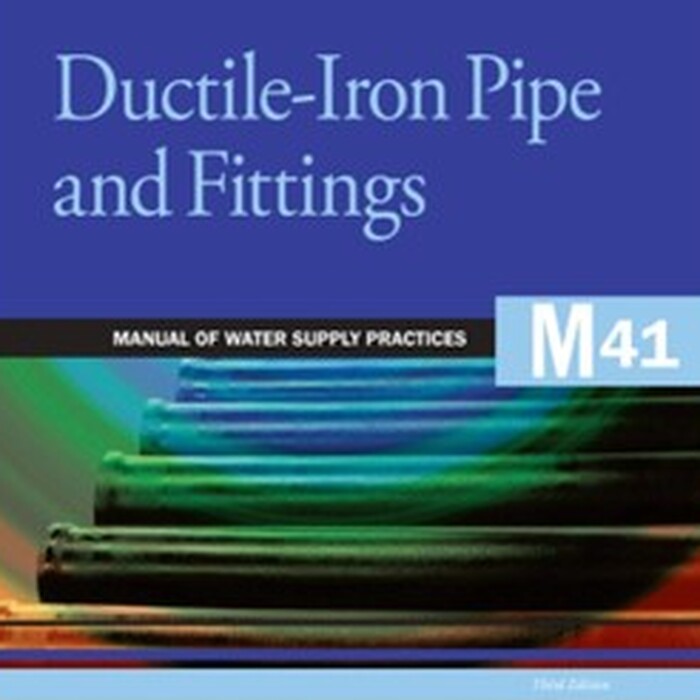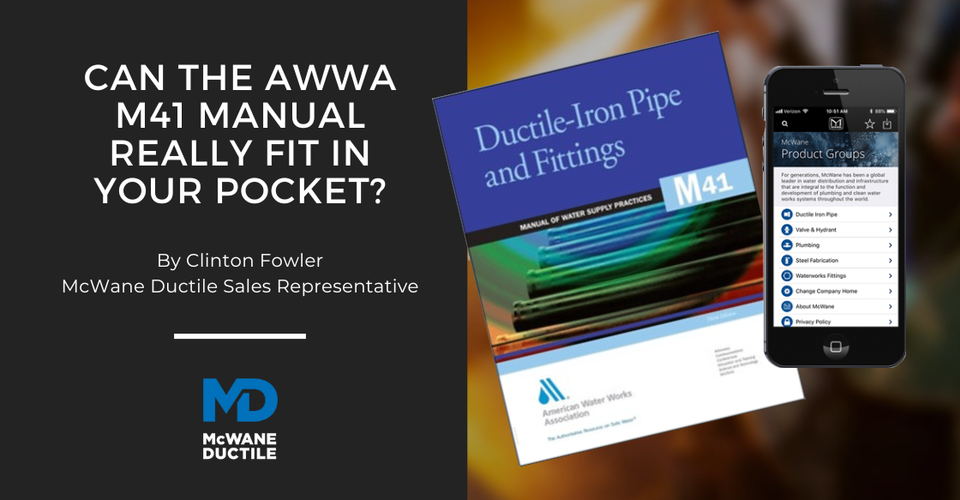Anyone who has ever studied or just skimmed the pages of the AWWA M41 Manual (M41) knows it helps to be of an engineering mindset to understand most of what’s within it. What if you could turn this indispensable reference into a simplified, easy-to-access tool that fits your pocket? Well, the McWane Pocket Engineer does just that! In this Iron Strong Blog, we will discuss the many Pocket Engineer (PE) components and how this real-time application utilizes important aspects of the M41 Manual to simplify life for you, the water professional.

FIRST, A BRIEF HISTORY OF AWWA & M41
To understand the importance of the M41 Manual and its relevance to the waterworks industry, let’s take a quick look at how it all started.
On March 29, 1881, the American Water Works Association (AWWA) was established to exchange information about water works management for the mutual advancement of consumers and water companies and to secure economy and uniformity in waterworks operations. AWWA focuses on promoting public health, safety, and welfare by improving the quality and quantity of water delivered to the public and developing and furthering understanding of the problems relating thereto.
Water conveyance through the centuries with pipe, be it 300-plus-year-old cast iron, 150-year-old wooden plank pipe, or modern and efficient Ductile iron pipe…reliably taking it from source to spigot, as shown in some photos below.

In 1996, the Ductile Iron Pipe and Fittings M41 Manual was created by a committee of water professionals, including technical experts and hands-on producers from each domestic Ductile iron-producing company.
The M41 Manual is a comprehensive collection of all the design procedures, manufacturing and quality conformance guidelines, installation recommendations, and other standards pertaining to Ductile iron pipe (DI pipe) and fittings, now published in a single book. The 2009 edition is alternately well known as the Third Edition of the AWWA M41 Manual.
Alternate pipeline materials commonly used in the utility industry, such as PVC, HDPE, and Steel, each have a similar version of AWWA known as the M23, the M55, and the M11.
TAKING IT FROM PAPER TO POCKET ENGINEER
In mid-2011, before rebranding the group of long-standing companies now known as McWane Ductile, an enterprising Product Engineer at one of those companies, began developing the concept of a digital solution for the M41 Manual. What grew from a collection of powerful computational Excel spreadsheets was introduced as a mobile and computer app in 2012 during the Annual AWWA ACE Conference. The app is now widely known as the McWane Pocket Engineer.
It contains a wide array of product, industry, and company information, along with 12 specific calculators that comprehensively capture the primary design routines for Ductile iron pipe, per and in exact conformance with 250 pages of the AWWA M41 Manual.

HOW DOES THE POCKET ENGINEER DIGITALLY DELIVER THE M41 TO ME?
Now that you know the background, let’s closely examine the digital app and how the AWWA manual of water supply practice has been transformed into simple yet powerful tools for water distribution systems designers and operators.
Hydrotest Allowance Calculator – Found in Chapter 11 of M41
Hydrostatic testing is one, if not the most, important aspect of Ductile iron pipe installation. It is the final 'proof' of fitness for service of the installed pipeline, encompassing manufacturing and installation components of assurance. This calculator computes the Testing Allowance (makeup water at the test’s end) per the latest ANSI/AWWA C600 RVE 2010.
OD & ID Calculator – Found in Chapter 4 of M41
Inevitably, there's a phone call or email concerning Outside Diameters (OD), Internal Diameters (ID), and tolerances of Ductile iron. We have made it as easy as simply putting in your pipe size to tell you everything you'll need to answer those questions.
Thrust Restraint Calculator – Found in Chapter 8 of M41
Even if "math is your thing," the design procedure for determining the required lengths of restrained joints within a pipeline is lengthy and complex. With the simplest of known input required, this calculator computes, in a single click, over 100 results detailing the restraint requirements on each side of every fitting or other thrust-generating appurtenance available in the input diameter, with and without polyethylene encasement.
Energy Savings Calculator – Found in Chapter 9 of M41
Although mentioned in the M41 chapter 9, this calculator's construction is based on information and design guidance from a Hydraulic Analysis of Ductile Iron Pipe publication by DIPRA.org.
What does it cost to operate a system based on Pumping Costs? And how does DI pipe compare to other pipe materials? Enter your basic pipeline data to instantly capture flow rate, velocity, head loss, annual pumping cost, and the present worth value savings realized by constructing and operating a Ductile iron pipeline versus alternate materials such as PVC, HDPE, steel, and PCCP (concrete).
HDD Geometry Calculator – Variable Profile Calculator- Found in Chapter 12 of M41
What will it take to go under a road, a body of water, an existing pipeline, or any other obstacle in the path of a proposed pipeline? And what if the pipeline is NOT being constructed via typical open-trench methods? Use this calculator to quickly gather an optimized directional drilling profile with minimal user input towards maximum understandable results. It computes the average deflection, the radius of the arcs in the bore, and the actual drilling angle in and out of the bore. This calculator also details the critical inflection points of the directional drill path and whether a central flat section is involved.
Flow Calculator – Found in Chapter 9 of M41
What flow rate is best through that size pipe? How about that head loss? Choose any diameter and instantly obtain the flow rate (gpm) and head-loss (ft/1,000 ft) results for the design-default velocity of 5.0 fps. Override any result values to quickly recalculate all other parameters at the touch of a button. (Employs the standardized Hazen-Williams hydraulic equations and principals).
Radius Calculator – Found in Chapter 11 of M41
To bend or not to bend, let Mcwane tell you what’s possible. The pipeline radius calculator follows AWWA C600 methodology and product data per diameter to gauge the tightest radius achievable for a pipeline section without fittings involved. It also considers additional deflection limitations if restrained joints or locking gaskets are involved.
Thickness Calculator – Found in Chapter 4 of M41
Math, math, and more math…again, let the McWane PE do the challenging work! With minimal input required and computed in absolute conformance with the iterative design process outlined in the AWWA C150 standard, the appropriate pipe wall and classes are quickly calculated for all five (5) standardized Trench Types in full accordance with the ANSI/AWWA C150 Thickness Design Standard for Ductile Iron Pipe, latest revision. Designs are performed for internal pressure, bending stress, and barrel deflection designs, with the worst of these three structural considerations declared the ruler for selecting the pipe wall.
Internal Pressure & Materials Comparison Calculator – Found in Chapter 4 of M41
How do you analyze the Hoop Stress of a given pipe in various materials? Start with the yield strength of materials first. If you need to learn such information off-hand, the McWane PE has the calculator you need! This calculator will test the Internal pressure of DI Pipe, PVC, HDPE, and Steel.
Tonnage Calculator – Not found in the M41 but based on the AWWA C151 standard (iron weight only)
This calculator quickly determines how many tons of pipe your project comprises. Using the diameter, class, and footage of said pipe, the PE app shows the tonnage of that section. Have multiple sections or diameters you want to check on? You can calculate up to five separate and five different pipe sections at a time. This calculator will not only tally the tonnage for each section, but it will add all the sections together and give you a total amount for all five sections combined.
Volume Calculator – Not found in M41 but based on the AWWA C151 and C150 standards
Between an 8" Tyton® 350 and an 8" Tyton 52, there might not be a huge difference in the water volume in the pipe. But maybe you are concerned about the difference between an 8" pipe and a 12" pipe. Based on the C151 and C150 Standards, the Volume Calculator will help you. It will also total the combined volume if you have a line that is 12" and reduced to 8" and are looking at how much water will be in that section of pipe.
Yes, the M41 Can Fit In Your Pocket!
As mentioned at the start of this blog, the waterworks industry applies many complex concepts and mathematical calculations to ensure safe, clean, and reliable water delivery. Don’t fret. McWane has made life in the Ductile iron pipe world easier by developing the Pocket Engineer, which allows users to retrieve pertinent technical information from the collection of AWWA/ANSI Standards for Ductile Iron Pipe and Fittings – the M41 – and access calculations essential in the field that would otherwise take valuable time to compute. The application works on any mobile device or desktop computer. Download it today at https://www.mcwaneductile.com/learning-center/pocket-engineer/. As always, if you have any questions or want more information, please contact your local Mcwane Ductile sales representative.







